Strange History of Three Oregon Coast Landmarks - Tillamook Bay
Published July 2008
By Andre' Hagestedt and Tobi Nason
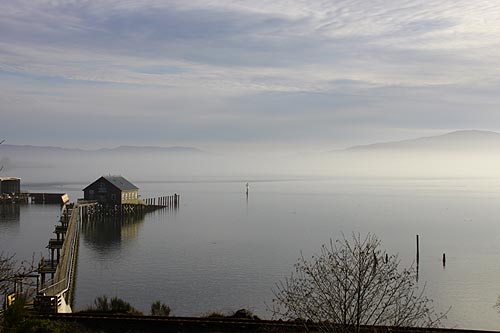
(Tillamook, Oregon) - A ghost of a ghost town. A giant letter "G" sitting on a hillside. And even a sizably smaller "B" on the side of a nearby hill.
They're all part of Tillamook County history, with some surprising realities lurking behind the legends. And yet, there are still numerous mysteries in there.
They all take place around the Tillamook Bay, with the freaky facts behind the briefly thriving resort of Bayocean, along the Tillamook Spit, and the big letters sitting above Garibaldi and tiny Barview.
The Letters of Garibaldi and Barview
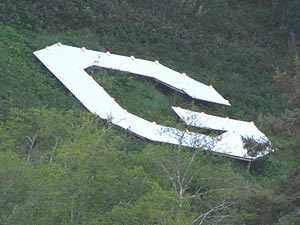 |
| Garibaldi's big G |
As one approaches Garibaldi from the south on the inland curve from Tillamook, the Big G shines brightly up on the mountainside. It appears sort of regal, as if one were entering a duchy or vast estate of some sort. Garibaldi, a small coastal fishing town, rife with marinas and RV parks, is not a vast estate. One wonders what the G "stands" for, if anything other than Garibaldi.
The, just around the bend, in Barview, you may spot a big "B" painted into a concrete chunk on the side of the hill - sort of the little brother of Garibaldi's G, and its less affluent relative as well.
Facts are one thing - folklore another. The facts of the Big G are getting lost in the mix of hearsay and half-truths. Dig a little deeper, and you’ll find many don’t know much of anything about it. Some thought the fire department maintained it. One person thought it had some nautical function.
Facts: It originated in 1930 by Garibaldi's junior high school class. They had passed through Amity on a school trip, saw the mountainside "A" and debated the idea of a "G" for their little town. The site itself is a 45-minute walking distance from what was then Gaibaldi High School, now Garibaldi Grade School. Off to a rocky start, since enthusiasm for a big G waxed and waned, the idea got pushed by Roy Albers and by-laws were drawn up by the student body. Local merchants donated supplies, and a man named Otto Schrader, plant manager for Hammond-Tillamook Lumbar Company, supplied the construction plan. More details of the actual first construction can be found at the City Hall in Garibaldi.
The first G burned down. The second G lasted 40 years, until deterioration set in and a new one was built by the fire department, made of metal.
To get an update on the Big G," Carolee North is the one to speak with. She is designated president of "The Friends of Big G." She helped organize the loosely organized group. In 1999, she and a group of concerned citizens started a program to raise funds for the maintenance of the G, which in this case meant replacing all the light fixtures and bulbs with new fixtures made of unbreakable plastic. Fundraising involved citizens "buying a light." They received more donations than necessary at the time. The money was put into an account for future maintenance.
Carolee says that that the Big G is "very loved. It is an important source of pride and ownership to the people of this area." She says the Coast Guard pilots use it as a landmark. The Fire Department and Coast Guard help maintain the grounds, as do the Boy Scouts. The color of the lights are also changed for different effect. Red, white and blue reigned after September 12, 2001 (the day after the 9-11 attacks) and stayed until the following 4th of July.
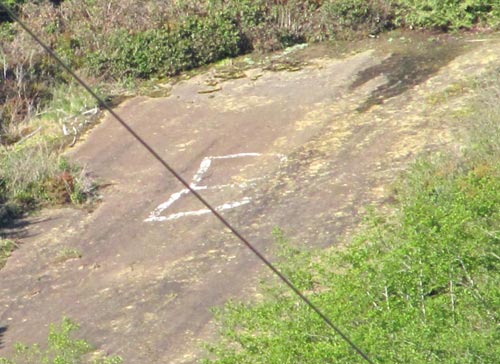 |
| The "B" of Barview, barely visible on the patch of concrete in the hill - apparently the low budget brother of Garibaldi's "G" |
By comparison, the Big B (for Barview) has no history, no story, no friends. The B resides on the eastside hill of 101, although it has faded quite a bit in recent years. It can't be seen from Hwy. 101. The best view - and only view - is from Barview Jetty County Park. Drive out to the parking lot, turn around and head back to Hwy. 101. Halfway between parking lot and railroad tracks, look east, up to the hillside. That's right, there's the B.
The most "history" available seems to be that it is a fairly recent development. Darlene Johnson of the local Barview Store says sometime between 1997 and 1999, it "suddenly appeared." It looks to be white paint on a rock face. Other than that, as Darlene Johnson says, "No one knows." Larry of Tillamook County Park Services used to tell his kids that the B stands for Barview Bigfoot. He doesn't know either, but Bigfoot could easily become folklore in no time.
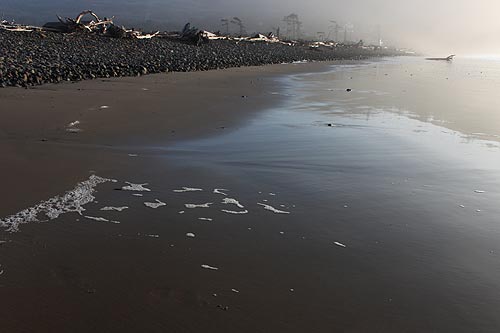
The Ghost Town That is No More
(Above: Bayocean today). What you now see as the Tillamook Spit - miles of what seems like unending dunes and hiking possibilities - was for a brief period a thriving resort town that hosted thousands of people in the summertime. But after only 15 years of existence, the place gradually fell into greater and greater disrepair, eventually becoming a ghost town.
Now, more than 100 years later, nothing tangible remains of this place. It is the ghost of a ghost town, completely reclaimed by nature.
It all began around 1906, when a Kansas developer named Potter bought the land with his son. They set about building this grandiose resort, which included two hotels, a drug store, grocery store, a “bungalow city” and a “tent city,” as well as tennis courts, a natatorium that housed a movie theater, a tin shop, bowling alley, a cannery and other attractions. A diesel engine provided electricity and the area had a decent phone system. Miles of roads were even built, and the place had its grand opening in 1912.
There were around 600 plots set for homes, many of which were built, and Bayocean was well on its way to become the "Atlantic City of the West." That was the plan, and that was the ad campaign, but it never quite materialized.
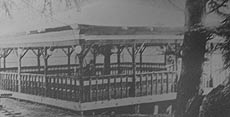 |
| The pavillion at Bayocean during its heyday |
A yacht carried folks to the spit and back to the mainland, where the trains connected tourists and vacationers to the Portland area. For at least a few years, there were about 50 fulltime residents, including a man who pioneered the use of crab pots on the north Oregon coast. During the summer, thousands flooded the town and took advantage of the fun stuff. There and along the ports of Garibaldi and Tillamook, it was described as “activity everywhere.”
The honeymoon was relatively short. Its heyday lasted only a few years. The first man to buy a lot from Potter’s company and began a feud that was the beginning of the end. Francis Mitchell started Bayocean’s first businesses and the post office, but he also soon began accusing Potter of fraud. This feud lasted for years and split the town’s growing residency. Eventually, Potter’s company failed, and the resort changed hands a few times, closing and reopening periodically throughout the 20’s and 30’s.
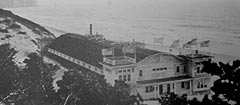 |
| The natatorium had a theater inside as well |
By the late 20’s and 30’s, erosion began reclaiming the spit, and some buildings started to fall into the sea. Each winter brought some new disaster. The construction of the jetties at the mouth of the bay is considered to be the culprit, as these change the action of the waters and how they affect the shoreline (much in the same way the construction of the jetties at the mouth of the Columbia changed the shorelines of Warrenton and Seaside).
The Great Depression and wartime finally permanently killed off the resort. Meanwhile, more buildings fell into the sea over the years. Eventually, many of these miles of roads, attractions and hotels disappeared. But not before falling into serious disrepair for many years. By the 30’s or 40’s, there are reports of buildings devoid of occupants and empty, broken windows “staring out like soulless, lifeless eyes.”
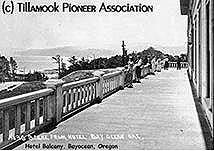 |
| The grand hotel at Bayocean at the resort's height |
It went through several phases of being occupied by a few here and there who tried to restart some of the businesses and even an artist colony or two. About 1970, there is one report from a former local who grew up there when the Potter family kickstarted their venture, telling about what he saw in the 60’s. At the time, he was in his 80’s, and rather forlornly, even bitterly, describes seeing a “hippie” town occupying the area.
The natatorium started crumbling in 1936, completely disappearing by 1939. The Post Office shut down in 1953 after the majority of the residents moved away, with, ironically, Mitchell being the last to leave.
A year later, the spit was breached by a massive storm. That eventually “healed” itself, but Bayocean was firmly a ghost town and doomed.
The rest of it was bulldozed over in the 70's by the government.
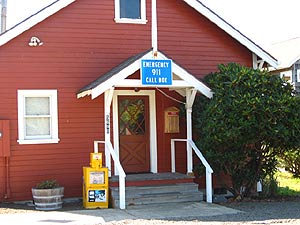 |
| Cape Meares' community center was once the school and church for Bayocean. It was picked up and moved to its current spot. |
Supposedly, at extremely low tides, you can see the remnants of a boiler in the water just off the town of Cape Meares. Some residents of that tiny village will tell you the diagonal shoreline of the village was Third St. at the height of Bayocean's brief romp. There was a 1st St. and Second St. back then. That's how much storms and tidal conditions had destroyed the place in the middle part of the century.
A few buildings were saved and moved to Cape Meares. The community gathering place there is the former school and church from the old resort. There is some talk you may occasionally find part of a structure in the form of a chunk of concrete or metal somewhere in the dunes.
That’s all that is left of a true ghost town. Where to stay for all this - Where to eat - Map and Virtual Tour
More About Oregon Coast hotels, lodging.....
More About Oregon Coast Restaurants, Dining.....
LATEST Related Oregon Coast Articles
Likely just before dawn best hour but peak happens during daylight. Weather
Dark Sky Week is Prime Along Oregon Coast: Where and Where Not to Go
General guide to dark sky viewing from south to north coast. Astronomy
Sizable Price Drop, Deals in Lincoln City During Quiet of April on Central Or...
20 perc off at A1 Vacation Rentals across its roster, including Gleneden Beach. Lincoln City specials
Upcoming S. Oregon Coast Events Include Gem Show, History: Coos Bay, Bandon
May 6 talk at Coos History Museum, Mayfly Fest May 17, Bandon Rock / Gem Show June 7,8
Washington Coast Cleanup on April 19 - Coinciding with Oregon Coast's SOLVE E...
From the Puget Sound to Long Beach, alongside Oregon's cleanup. Washington coast events, Seaside events
Astoria's Riverwalk Gets New Lighting, More N. Oregon Coast Roadwork
Delays coming this summer, but the riverwalk has a new look. Seaside, Cannn Beach
April Gets Even Cheaper Midweek at Depoe Bay, Lincoln City: Oregon Coast Deals
Off-season rates plus more at Keystone Vacation Rentals. Depoe Bay lodging specials, Lincoln City hotel reviews, Newport hotel reviews
Washington Coast Begins Week of Clam Digs, April 12 Through 18
Long Beach, Twin Harbors, Mocrocks and Copalis at different times. Washington coast events
Back to Oregon Coast
Contact Advertise on BeachConnection.net
All Content, unless otherwise attributed, copyright BeachConnection.net Unauthorized use or publication is not permitted









































